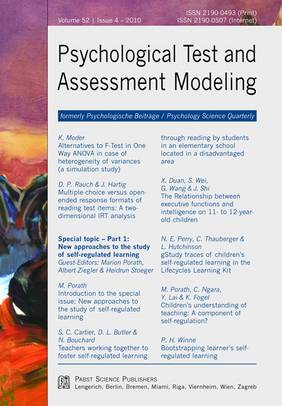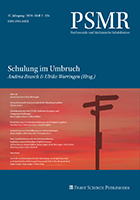Psychological Test and Assessment Modeling, Volume 52, 2010 (4)
Karl Moder
Alternatives to F-Test in One Way ANOVA in case of heterogeneity of variances (a simulation study)
Abstract | ![]() PDF of the full article
PDF of the full article
Dominique P. Rauch & Johannes Hartig
Multiple-choice versus open-ended response formats of reading test items: A two-dimensional IRT analysis
Abstract | ![]() PDF of the full article
PDF of the full article
Special topic - Part 1:
New approaches to the study of self-regulated learning
Guest-Editors: Marion Porath, Albert Ziegler & Heidrun Stoeger
Marion Porath
Introduction to the special issue: New approaches to the study of self-regulated learning![]() PDF of the full article
PDF of the full article
Sylvie C. Cartier, Deborah L. Butler & Nancy Bouchard
Teachers working together to foster self-regulated learning through reading by students in an elementary school located in a disadvantaged area
Abstract | ![]() PDF of the full article
PDF of the full article
Xiaoju Duan, Siwang Wei, Guiqing Wang & Jiannong Shi
The relationship between executive functions and intelligence on 11- to 12-year-old children
Abstract | ![]() PDF of the full article
PDF of the full article
Nancy E. Perry, Carolyn Thauberger & Lynda Hutchinson
gStudy traces of childrens self-regulated learning in the Lifecycles Learning Kit
Abstract | ![]() PDF of the full article
PDF of the full article
Marion Porath, Constantine Ngara, Yuan Lai, Krista Fogel & Judy Lupart
Childrens understanding of teaching: A component of self-regulation?
Abstract | ![]() PDF of the full article
PDF of the full article
Philip H. Winne
Bootstrapping learners self-regulated learning
Abstract | ![]() PDF of the full article
PDF of the full article
Dankmar Böhning, Heinz Holling & Klaus D. Kubinger
In memoriam Anton K. Formann![]() PDF of the full article
PDF of the full article
Alternatives to F-Test in One Way ANOVA in case of heterogeneity of variances (a simulation study)
Karl Moder
Abstract
Several articles deal with the effects of inhomogeneous variances in one way analysis of variance (ANOVA). A very early investigation of this topic was done by Box (1954). He supposed, that in balanced designs with moderate heterogeneity of variances deviations of the empirical type I error rate (on experiments based realized α) to the nominal one (predefined α for H0) are small. Similar conclusions are drawn by Wellek (2003). For not so moderate heterogeneity (e.g. σ1:σ2:...=3:1:...) Moder (2007) showed, that empirical type I error rate is far beyond the nominal one, even with balanced designs. In unbalanced designs the difficulties get bigger. Several attempts were made to get over this problem. One proposal is to use a more stringent α level (e.g. 2.5% instead of 5%) (Keppel & Wickens, 2004). Another recommended remedy is to transform the original scores by square root, log, and other variance reducing functions (Keppel & Wickens, 2004, Heiberger & Holland, 2004). Some authors suggest the use of rank based alternatives to F-test in analysis of variance (Vargha & Delaney, 1998). Only a few articles deal with two or multifactorial designs. There is some evidence, that in a two or multi-factorial design type I error rate is approximately met if the number of factor levels tends to infinity for a certain factor while the number of levels is fixed for the other factors (Akritas & S., 2000, Bathke, 2004).
The goal of this article is to find an appropriate location test in an oneway analysis of variance situation with inhomogeneous variances for balanced and unbalanced designs based on a simulation study.
Key words: heteroscedasticity, analysis of variance, alternatives
Karl Moder, PhD
University of Natural Resources and Applied Life Sciences
Institute of Applied Statistics and Computing
Peter-Jordan-Str. 82
A-1190 Vienna, Austria
karl.moder@boku.ac.at
Multiple-choice versus open-ended response formats of reading test items: A two-dimensional IRT analysis
Dominique P. Rauch & Johannes Hartig
Abstract
The dimensionality of a reading comprehension assessment with non-stem equivalent multiple-choice (MC) items and open-ended (OE) items was analyzed with German test data of 8523
9th-graders. We found that a two-dimensional IRT model with within-item multidimensionality, where MC and OE items load on a general latent dimension and OE items additionally load on a nested latent dimension, had a superior fit compared to an unidimensional model (p ≤ .05). Correlations between general cognitive abilities, orthography and vocabulary and the general latent dimension were significantly higher than with the nested latent dimension (p ≤ .05). Drawing back on experimental studies on the effect of item format on reading processes, we suppose that the general latent dimension measures abilities necessary to master basic reading processes and the nested latent dimension captures abilities necessary to master higher reading processes. Including gender, language spoken at home, and school track as predictors in latent regression models showed that the well known advantage of girls and mother-tongue students is found only for the nested latent dimension.
Key words: reading test, multiple-choice items, open-ended items, item response theory, components of reading ability
Dominique P. Rauch
Research assistant
DIPF, German Institute of International Educational Research
Schloßstr. 29
60486 Frankfurt am Main, Germany
rauch@dipf.de
Teachers working together to foster self-regulated learning through reading by students in an elementary school located in a disadvantaged area
Sylvie C. Cartier, Deborah L. Butler & Nancy Bouchard
Abstract
A key question for the educational research community concerns how teachers can adapt theories and practices supported by the scientific literature in ways that meet the particular needs of students in classrooms. The research reported here takes up that question by investigating how a team of teachers in an elementary school in a disadvantaged area built from research and theory to enact, try out, and refine classroom practices supportive of self-regulated LTR in their subject-area classrooms in light of their students needs. Our goals were to (1) describe what classroom activities participating teachers planned and implemented to integrate attention to the curriculum with support for self-regulated LTR; (2) evaluate the match between teachers practices and recommendations from the literature, as represented in the framework on which they were drawing; and (3) trace how practices enacted by teachers could be related to the perceptions and learning processes of their 123 Grade 5 and 6 students. A key finding was that teachers were successful in embedding activities into classrooms that engaged students in self-regulation, particularly use of cognitive strategies. However, we also found that the practices enacted did not sufficiently push students towards self-conscious, deliberate self-direction of learning. Implications are drawn about how classrooms practices can be constructed to take into account qualities of LTR contexts and supports necessary to foster success in school by young, at-risk learners. Discussion also focuses on benefits and challenges when teachers work together to adapt practices for use in subject area classrooms in ways that are responsive to student needs.
Key words: Self-regulation, learning through reading, cognitive strategies, metacognition, assessment, classroom practices, teaching, elementary school, at-risk learners
Sylvie Cartier
Professeure agrégée
Département de Psychopédagogie et Andragogie
Université de Montréal
Case postale 6128
Succursale Centreville Montréal
Québec, H3C 3J7, Canada
sylvie.cartier@umontreal.ca
The relationship between executive functions and intelligence on 11- to 12-year-old children
Xiaoju Duan, Siwang Wei, Guiqing Wang & Jiannong Shi
Abstract
This study investigated the structure of the executive functions and their roles in intelligence on sixty-one children aged 11- to 12-year-old. Six executive function tasks and one intelligence test were carried out in the study. The confirmatory factor analysis has shown that the executive functions could be separated into three factors: updating, inhibition and shifting. These three factors were moderately correlated with each other, but were clearly separated. The present results were in line with previous findings from adults. There were significant correlations between measures of updating, inhibition and shifting, and intelligence. However, only the correlation between updating and intelligence remained significant when the correlations among executive functions were controlled. The study gave some theoretical support to the effect of executive functions training on intelligence and self-regulated learning.
Key words: intelligence, executive functions, children
Jiannong Shi, PhD
Key Laboratory of Mental Health
Institute of Psychology
Chinese Academy of Sciences
10A Datun Road, Chaoyang District
100101 Beijing, PR China
shijn@psych.ac.cn
gStudy traces of childrens self-regulated learning in the Lifecycles Learning Kit
Nancy E. Perry, Carolyn Thauberger & Lynda Hutchinson
Abstract
Evidence is accumulating that young children engage in self-regulated learning (SRL). One challenge is obtaining valid and reliable measures of childrens SRL. The gStudy software and its associated Learning Kits hold promise in this regard. We used gStudy to trace grade 1 childrens SRL as they studied the lifecycle of frogs in the Lifecycles Learning Kit (LLK). Children studied two interactive information texts that described the lifecycle of frogs and provided opportunities for SRL. After reading each text, children completed note templates configured for recording observations, asking questions, making predictions, and self-evaluating learning. Finally, they used gStudys concept mapping tool to group key concepts across texts. gStudy traces of childrens SRL, responses to comprehension questions, observation logs, self-evaluation templates, and concept maps were analyzed for evidence of (a) what children learned and (b) how they regulated learning. Results indicated participants achieved high text-based comprehension and high SRL. Also, statistically significant positive correlations existed between teachers ratings of students achievement and students achievement on LLK tasks, and between students SRL in the LLK and their achievement on LLK tasks. Children reported high motivation for studying with the LLK. Qualitative analyses of childrens observation logs and concept maps reveal their depth of understanding.
Key words: self-regulated learning, motivation, text comprehension, children, observation logs
Nancy Perry, PhD
Department of Educational and Counselling
Psychology, and Special Education
University of British Columbia
2125 Main Mall
Vancouver, BC V6T 1Z4, Canada
nancy.perry@ubc.ca
Childrens understanding of teaching: A component of self-regulation?
Marion Porath, Constantine Ngara, Yuan Lai, Krista Fogel & Judy Lupart
Abstract
Childrens understanding of teaching and the conceptual relationships of this understanding to self-regulation and epistemic beliefs were explored by interviewing children identified as gifted, aged 6 to 17, about how they would like to be taught core academic subjects and how they would teach them to their own class. Data were analyzed using a constructivist approach to grounded theory informed by neo-Piagetian cognitive developmental theory. Five levels of understanding were articulated that formed a developmental trajectory in which young children saw teaching as action-based and concrete, focused on helping them do things right. By middle childhood, recognition of basic principles of teaching and learning were evident, then consciousness of the interdependence of teaching and learning. In early adolescence, emergent philosophical views on the nature of knowledge were expressed. Some of the older adolescents demonstrated personal philosophies of learning focused on growth, mutual partnership, and excitement about learning.
Key words: learning, teaching, children, grounded theory, self-regulation
Marion Porath, PhD
Department of Educational and Counselling
Psychology, and Special Education
The University of British Columbia
2125 Main Mall
Vancouver, BC V6T 1Z4, Canada
marion.porath@ubc.ca
Bootstrapping learners self-regulated learning
Philip H. Winne
Abstract
Self-regulating learners can be characterized as learners who actively research what they do to learn and how well their goals are achieved by variations in their approaches to learning. Extensive research on how and how well learners understand and apply the scientific method demonstrates that they encounter significant challenges in designing and validly interpreting experiments. I juxtapose these two views to make a case that learners need significant support to carry out a progressive program of research to make self-regulated learning productive. One key to this endeavor is gathering data that can accurately and systematically reflect how learning unfolds. I describe a software system called nStudy that is designed to do this, and I speculate on how software systems like nStudy can play powerful roles in improving learning and simultaneously advancing learning science.
Key words: learning technologies, metacognition, process feedback, self-regulated learning
Philip H. Winne, PhD
Faculty of Education
Simon Fraser University
Burnaby
British Columbia V5A 1S6, Canada
winne@sfu.ca























